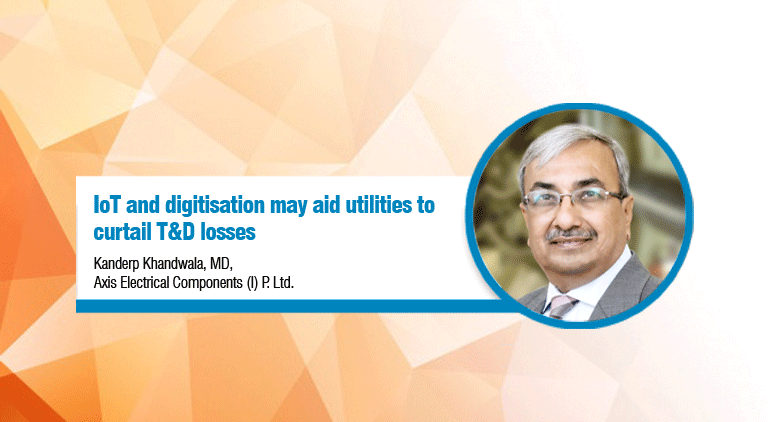IoT and digitisation may aid utilities to curtail T&D losses
By EPR Magazine Editorial January 10, 2020 11:28 am IST
By EPR Magazine Editorial January 10, 2020 11:28 am IST

IoT and digitisation bring with them the promise of reducing T&D losses for the utilities, which will bring in a lot of stability for the industry overall.
Kanderp Khandwala, MD, Axis Electrical Components (I) P. Ltd.
Kanderp Khandwala, MD, Axis Electrical Components (I) P. Ltd., in an interaction talks about the idea of implementing Internet of Things (IoT) and the digitisation in the Transmission and Distribution system and its impact on the entire industry.
Please walk us through your company’s journey till now.
Axis was set-up in 1994 by Nimish Taterh and me with a focus on exports. Axis first got into the business of AB cable accessories and distribution line hardware in 1998 when we first executed a major order for Yemen. Since Axis’s inception, we have focused on rigorous quality standards and international certificates, which made Axis amongst the first Indian companies to have products certified for UL 467 & BSEN 50164. Our export focus has also meant that we have consistently received export excellence awards from organisations such as IEEMA, along with a ‘Star Export House’ status by the Government of India and awarded the ‘Exporters Gold Card’ certification from Central Bank of India. Being one of the largest exporters from India, we have also received an SE 1A rating by CRISIL, reinforcing our status as a company with ‘High Financial Strength and the Highest Performance Capability’. Axis has always been forward looking and now we are focused on not just manufacturing world class products, but also growth in terms of technology, building a strong team and our commitment to our community which will help all of us to grow for another 25 years.
What value addition does Axis bring in for the electrical components?
Axis’s biggest value addition in the electrical component market in India is that due to our long international experience and large base in the export market, we have developed a global mindset which permeates the company in terms of quality of products, standards and certifications and finally the service that we offer customers. Competiting in the cutthroat international market bounded Axis
to constantly invest in R&D and in-house testing to make sure that our products are cutting edge with the highest levels of testing.
How do you gauge the current market for electrical components in India?
Rural electrification is one of the most important tasks which the government has undertaken over its 72 year history and this large mission means a large scope for growth for the entire industry. With the electrification of the entire country, Axis is optimistic on the positive growth of the industry
led by companies that focus on quality and standardisation of products.
What do you think about the demand-supply gap in the Indian electrical components market with respect to domestic manufacturing?
Many companies, including Axis, have focused their attention towards exports of electrical components but recently they have begun to realise the potential demand in India itself. With schemes like Saubhagya, Ujala and 100 percent electrification, the focus has shifted to the domestic market for the right reasons. Axis has also seen this opportunity and is making efforts to firmly establish itself as a major player in the market using its manufacturing strengths.
Which technology trends are shaping the market?
Internet of Things (IoT) and the digitisation of the Transmission and Distribution system are going to have a large impact on the entire industry. IoT and digitisation bring with them the promise of reducing T&D losses for the utilities which will bring in a lot of stability for the industry overall.
What, according to you, is a key challenge for the domestic manufacturing ecosystem?
Payments and defaults by Distribution Utilities is the biggest challenege faced by the industry at the moment because it has a reverberating downstream effect as it affects the working capital cycle of each business in the supply chain all the way down to the raw material suppliers. Red tape and bureaucracy remain key challenges despite initiatives like Make in India and digitisation of many government processes, have helped to reduce such red tape. However, yet a lot has to be done for a total transformation.
How would you define the roadmap of 2020 for Axis?
2020 marks the start of our 26th year of operations. It is a momentous occasion for us and we are looking at 2020 and all the years that follow it through with a strong focus on technological development, strengthening our sales team through well trained team members across India and globally and finally developing a strong base of channel partners across India.
We use cookies to personalize your experience. By continuing to visit this website you agree to our Terms & Conditions, Privacy Policy and Cookie Policy.